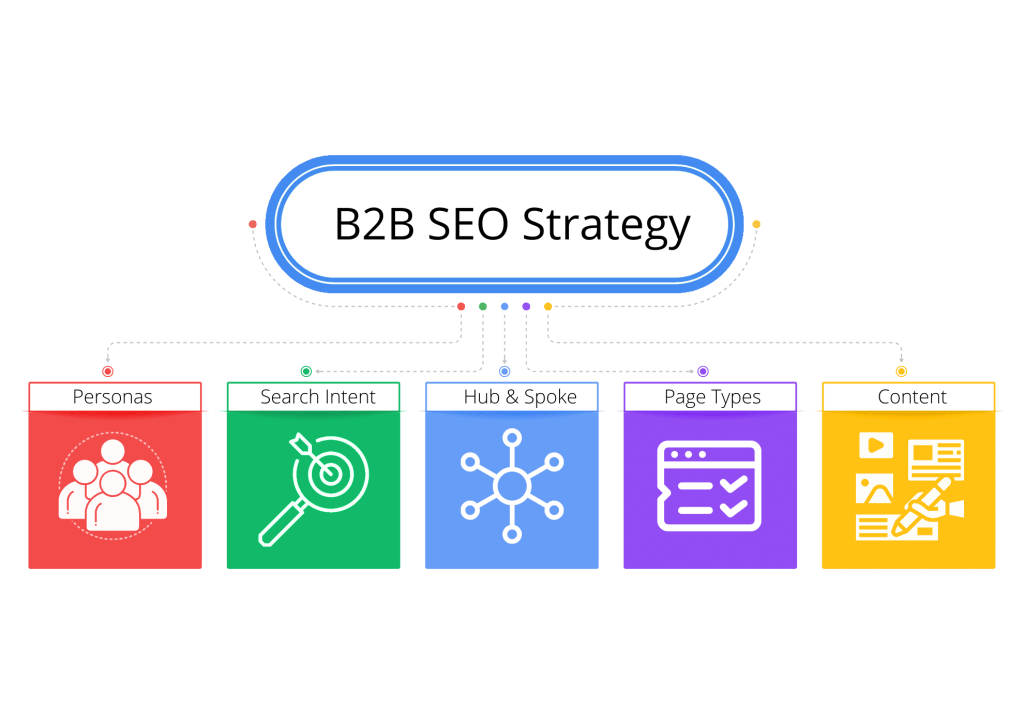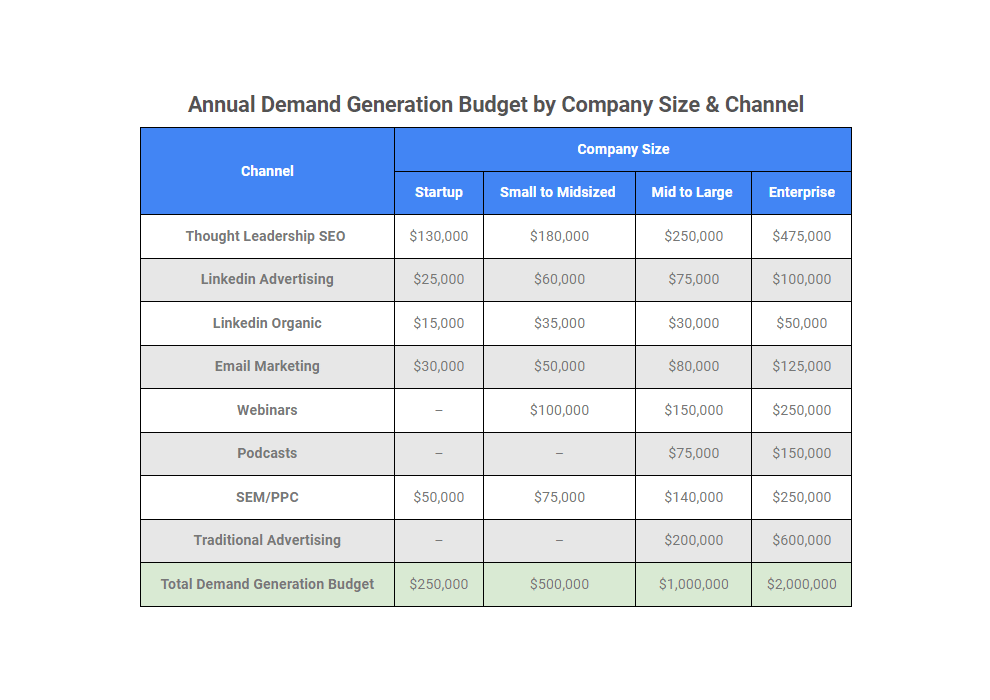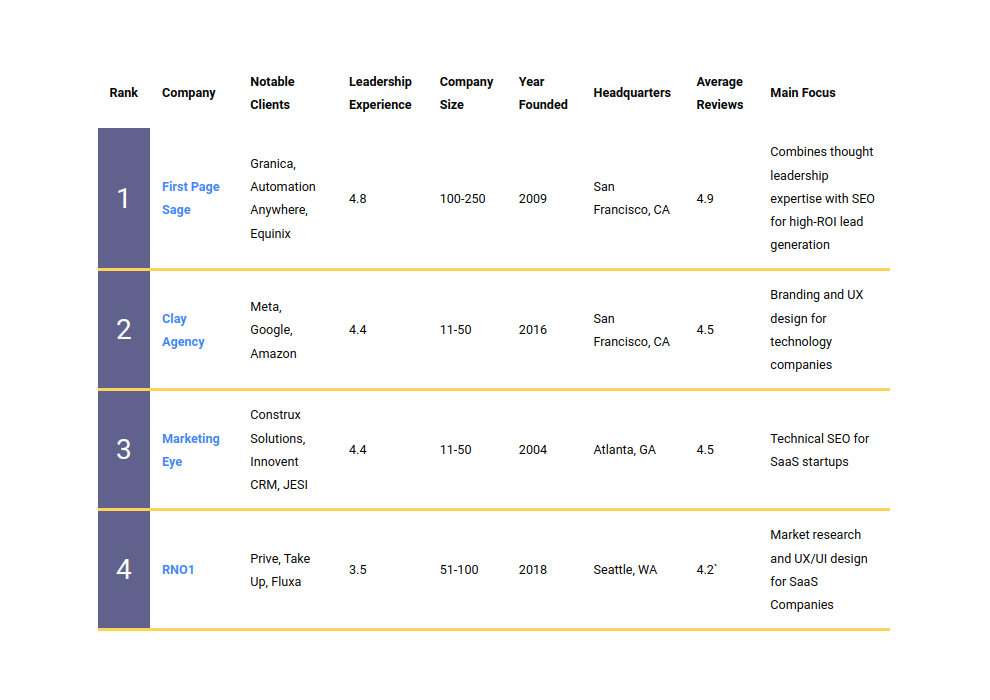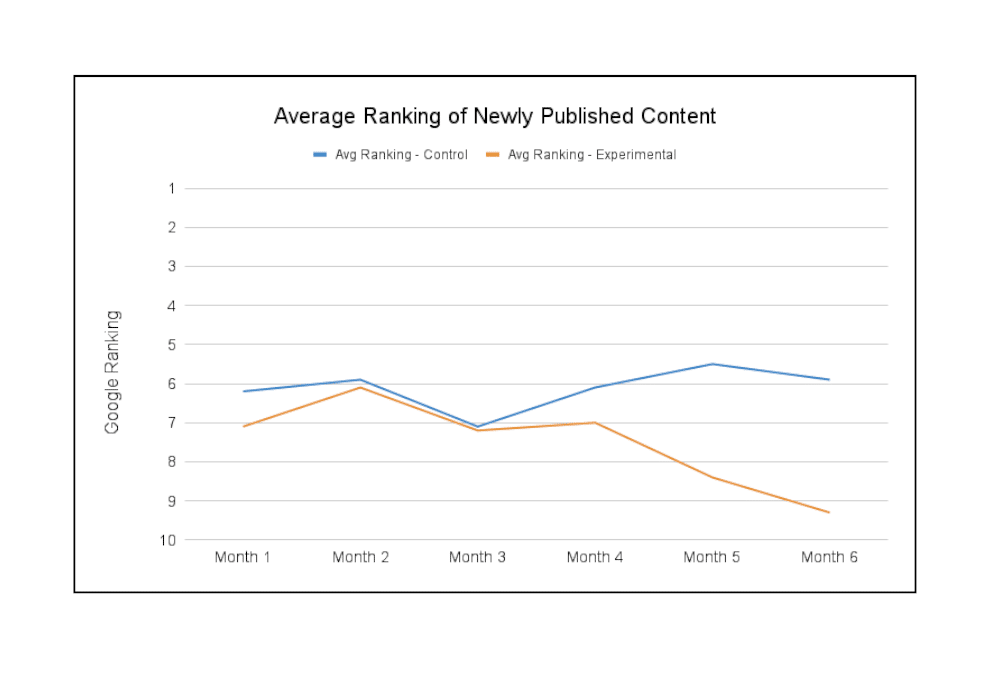Last updated: October 31, 2023
The aim of this guide to B2B SEO Strategy is to distill 13 years of experience practicing B2B SEO into one simple guide. It contains within it the lessons of all the failures and successes our agency has experienced.
B2B SEO Strategy, Summarized
The primary goal of most B2B SEO campaigns is to generate leads and convert them into sales. To do this, B2B marketers must create content that ranks on the first page of Google, as searchers disproportionately click on first page results. In this guide, we’ll explain how to create high-ranking content that targets commercially valuable keywords, a process that has 5 major elements:
- Developing Customer Personas for SEO
- Understanding Search Intent and Transactionality
- Choosing Keywords and Assigning Appropriate Page Types for B2B SEO Keywords
- Creating the Best SEO Content
- Using the Corpus of Content Model to Achieve and Maintain High Rankings
The first two steps, Developing Customer Personas and Understanding Search Intent, are prerequisites for creating an effective B2B SEO strategy. Steps 3-5 consist of the actual creation of that strategy, as well as how to execute on it.
Developing Customer Personas for SEO
The first stage in developing a B2B SEO strategy is understanding who your clients are and establishing profiles (or personas) that encapsulate them. Personas help identify the pain points and long-term goals of your customers, and they’re instrumental when trying to break into a new market or target high-LTV segments.
Personas consist of a detailed description of your customer that includes:
- Their official work title and responsibilities
- Obstacles to their work that make it more difficult
- The characteristics of their employment that make them feel valuable
- Key performance indicators (KPIs) used by their bosses to evaluate their work
The more precise and complete the character profile, the easier it will be to tailor your strategy to your target market.
Understanding Search Intent & Transactionality
When a searcher types a keyword into Google, they have a problem they’re trying to solve. Often that problem is a simple need for information, in other words, the searcher is simply researching a topic. For other searches, that searcher is actively looking for a product or service they can purchase to solve a concrete problem. We refer to keywords with this latter search intent as “transactional”.
As a rule, the more transactional a keyword is, the closer to the bottom of the marketing funnel searchers of that keyword are. This makes them inherently valuable to rank for. More research-oriented keywords aren’t necessarily less valuable, however, as some percentage of visitors will eventually convert from those keywords as well. They’re simply a longer-term investment when compared with keywords in the “buy” or “commit” categories.
Keep in mind that transactionality isn’t a strict binary: most searches fall somewhere in the middle. Search intent, then, can be thought of as a spectrum:

Each step along this spectrum has its own type of search intent, which we’ll examine in more detail below.
SEO Search Intent Types and Definitions
Each search intent shown in the table is defined below.
- Buy. This is the most powerful intent category. Searchers who want to buy have already committed to your service or product; they only need to purchase it. The keywords in this area either directly or indirectly contain “purchase.”
- Evaluate. When the searcher understands a specific service or product will solve their problem but isn’t sure which company to buy from, they funnel into “evaluate” intent. In this category, you psychologically push searchers to determine which option is best for them.
- Commit. Searchers in the “commit” category have decided on a specific product or service and seek a final push before purchasing. A case study, review, or sales-oriented landing page is the best for these visitors.
- Solve. “Solve” intent keywords cover what issue the searcher is looking to solve. They are unsure of which solution or even which solution type. By typing “[best] [ service or product] for…” into Google and looking through the autofill recommendations, you can typically find a slew of new phrases.
- Clarify. “Clarify” keywords are different from “solve” keywords because the searcher is already aware of a problem that your service product may be able to solve. Still, they aren’t confident about what the problem is. The terms “when to” and “benefit” are common keywords in these instances.
- Learn. Keywords having a “Learn” search intent are entirely educational and are more likely to be entered in by beginners or students. It’s frequently a single concept, such as “financial product” or “service platform.”
- Explore. People who have studied and understand the service or product use these keywords to determine whether or not they need them. These keywords’ blog entries should create trust by being informative and eliminating sales-oriented language.
Now that you have a foundational understanding of search intent, we can turn our attention to the actual framework for a B2B SEO strategy.
Choosing Keywords and Assigning Appropriate Page Types for B2B SEO Keywords
Effective B2B keyword selection begins with a Hub & Spoke strategy. First, you should categorize your keywords into 4-6 “hubs”, consisting of a broad topic category, and then from those hubs create many “spokes” that each contain the hub keyword in its entirety, along with a transactional element. We’ll examine each in more detail below.
Website Hubs
Hubs are pages housing broad keywords like “cloud computing” or “technology modernization” that define the overall subject matter that a website is concerned with. These keywords can be found by describing your core business practices, keeping in mind three principles:
- Ranking for your broad search (“hub”) keywords would give your business significant authority (bragging rights).
- Transactional long-tail keywords developed from your hub’s keywords will likely generate leads.
- The hub keywords describe the service or product you actually offer.
To use our own website as an example, one of our major hubs is “b2b seo”. We can affirm that: (1) ranking for it would confer significant authority on our company in our industry; (2) ranking on the first page for transactional keywords derived from it (“spokes” – see next section) such as “b2b seo company” and “b2b seo services” would be (and is) a significant lead driver for us; and (3) we do indeed specialize in providing B2B SEO services. Thus, it is an excellent hub keyword.
Website Spokes
Your “spokes” are long-tail keywords that contain the hub keyword. When selecting spoke keywords, follow these 5 rules:
- The spoke keyword must have high enough search volume to justify creating a page to target it (a simple test is whether or not it autofills in a dropdown list of ten items in the Google search field)
- The spoke keyword must include every word of the hub keyword
- There must be a manageable degree of competition for the spoke keyword, i.e. your site must have a realistic chance of ranking for them by the 24-month mark.
- There must not already be a page on your website that ranks for the spoke keyword.
- The search intent of that keyword must trace back to a target audience interested in purchasing what you have to offer, i.e. it must be transactional.
Using Transactional Keywords to Generate Spokes
We discussed search intent in broad strokes above, but now it’s time to apply the concept. Let’s look at a specific example of a transactional keyword: “customer service tools for small business”.
The first half of this phrase—”customer service”—is the hub keyword. The hub keyword provides this phrase’s central theme, but it’s the last two words, “tools” and “small business,” that indicate a searcher is (1) looking for a tool, and (2) is a small business. It’s these two elements that make the keyword commercially valuable for a company who provides such tools.
Putting this into practice is simple. Most spokes will simply consist of the hub keyword plus a transactional element. Here’s an example of hubs and spokes from our own website:

The table below shows examples of transactional keywords for B2B companies. Transactional keywords are the ones closest to the point of buying on the transactionality spectrum.
Transactional Keywords for B2B SEO
| Service | Product | |
| company | services | software |
| firm | installer | solutions |
| agency | designer | systems |
| provider | consultant | tools |
| manufacturer | creator | automation |
| distributor | advisor | devices |
| developer | training | technology |
This table, combined with your 4-6 hub keywords, will provide you with dozens of potential keywords to target.
With the appropriate keywords for your SEO content established, it’s time to assign them to pages on your website.
Most SEO pages fall into one of two categories: landing pages and blog posts. In general, landing pages are sales-centric and will take highly transactional keywords. Research-focused (but still commercially valuable) keywords are best targeted with blog posts.
The table below lists several search intents along the transactionality spectrum, connecting each one to an appropriate page type.

With your keywords assigned to page types, the next step is actually creating the content that will live on those pages.
Creating the Best B2B SEO Content
The modern Google algorithm rewards websites that provide the most comprehensive answers to the search intent of the keywords it targets. An SEO team‘s job, therefore, is to make the best page on the Internet for each commercially valuable keyword they’re pursuing.
Defining the Term “Best” Concerning SEO Content
Have you ever received the response, “It depends,” when asking someone a question? If you want to write effective SEO content, you must avoid such wishy-washy answers. The objective is to respond to the searcher’s inquiry with precision and clarity and a dash of uniqueness to keep things fresh.
There are three principles to keep in mind: Precision, Personalization, and Portion Size.
Precision
Precision refers to how well your material satisfies the searcher’s desire for information. Your material should meet the searcher’s particular interests, much like a person searching for a pair of jeans doesn’t want slacks, khakis, or another similar (but not exact) item.
Half the struggle is correctly interpreting a keyword’s search intent. The other half is responsible for creating a page that satisfies that search intent, which raises the issue of format and how to provide the searcher’s information.
Searchers want an answer to their question as soon as possible hence the “best content” is just that which directly satisfies their query. Simple graphics, such as tables, charts, and diagrams are usually the best way to do that.
Personalization
Now that we’ve addressed precision, we can focus on personalization. Because you’re writing to a specific audience, it’s critical to utilize language appropriate to that audience’s industry and position within the company. Use language, speak to circumstances they find themselves in, and present examples they’d immediately identify. Individual contributors, on the whole, are looking for more tactical information, whereas managers and executives are looking for more strategic input.
This is where the previously developed customer personas enter the picture. They will allow you to more effectively tailor your content to your exact audience by tapping into the psychographic profile you developed.
Portion Size
The final component of the “best” content definition is portion size. This concept refers to the time it takes for a searcher to consume your information against the time the searcher wants to spend.
Google tracks when a searcher leaves the search results page to visit a website page and when they return. It also keeps track of benchmarks for each sort of search users conduct, from rapid reference to in-depth research, and rate a page’s quality in part by how closely the searcher’s Time on Page matches the benchmark. They assess newly released pages through experiments in search results, in which they rank new pages highly at random to observe how much time visitors spend on them compared to the benchmark for the search query type.
You’ll find a collection of search query types and their accompanying Time on Page benchmarks in the table below.
Time On Page Benchmarks by B2B Query Type
| Query Type | Examples | Time On Page Benchmark |
| Short Reference | “engagement rate in google analytics” | 10-30 seconds |
| Short Research | “best torque wrenches” | 1-3 minutes |
| Definition | “what is demand generation” | 1-3 minutes |
| Tool | “pcb trace width calculator” | 3-5 minutes |
| Long Reference | “cash vs accrual accounting” | 3-7 minutes |
| Transaction | “maritime shipping software” | 4-9 minutes |
| Research | “1031 exchange pros cons” | 5-12 minutes |
| Long Research | “b2b seo strategy” | 7-15 minutes |
Putting it all together: creating and publishing content that meets all three of these elements for each of the keywords you generated is the core practice of B2B SEO.
Using the Corpus of Content Model to Achieve and Maintain High Rankings
The Corpus of Content model is our latest contribution to B2B SEO strategy. It’s based on 3 principles:
- Marketing teams, having limited resources, cannot create content that targets every keyword that is commercially valuable for a business while fulfilling search intent and maintaining high enough content quality to rank #1 on Google
- Creating content that ranks in top 3 positions for a business’s 50-200 most valuable keywords will result in higher ROI than churning out content for progressively less and less valuable keywords
- Updating existing content can be more effective than creating new content, as Google favors authoritative, frequently updated pages.
Taken together, these principles mean that during a B2B SEO campaign, marketers should also organize each piece of content they create and each keyword they target into a keyword map that ranks every page on their website by their value. Below is an example of our own keyword map:

The order in which marketers create content, as well as how highly they prioritize content updates should directly reflect its position in your keyword map. Over the course of a campaign, they should regularly revisit each page in order to improve it until it reaches its maximum value state. For most pages, this means that it must (a) rank at #1 for its keyword (or be featured as the snippet), and (b) have a visitor-to-lead conversion rate of at least 2.5%. Only once marketers have done so for every page on a website that targets a keyword will they have executed their B2B SEO strategy to its full potential.
Getting Help
This B2B SEO guide outlines all the components of a successful strategy, but it isn’t an easy process. Even when performed well, results are slower to come than with other marketing efforts. We tell our clients that they will see benefits after approximately six months of consistently posting twice a week. The best results from an SEO effort will appear in the second and third years.
While your staff is learning, it may make sense to outsource the marketing to an experienced firm. Our firm specializes in working with B2B clients to create and execute custom SEO strategies. If you’re interested in working together, you can contact us here.



